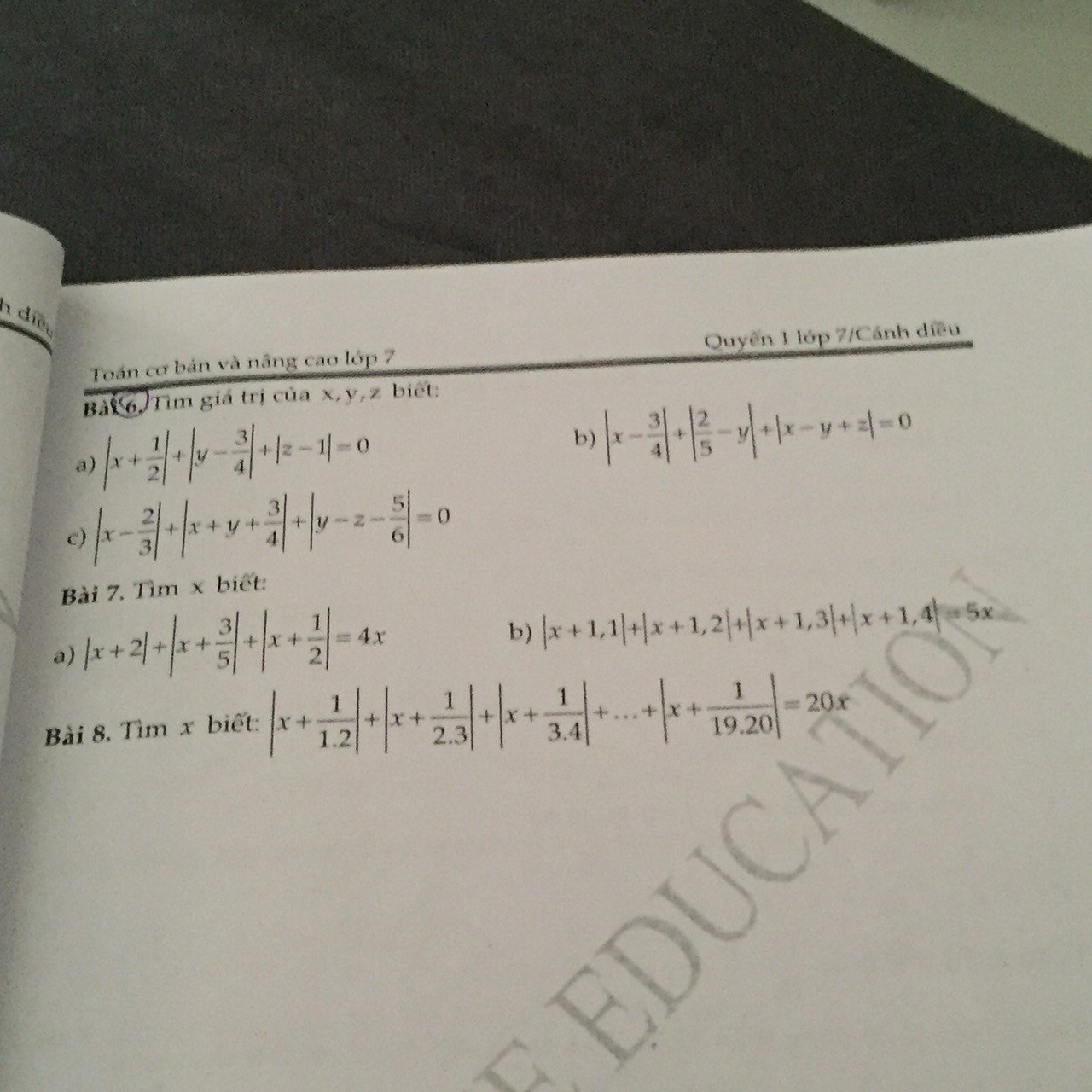 giúp em bài 6 vs ạ
giúp em bài 6 vs ạ
Hãy nhập câu hỏi của bạn vào đây, nếu là tài khoản VIP, bạn sẽ được ưu tiên trả lời.


Bài 5:
a: \(\left|-\dfrac{3}{5}+\dfrac{1}{2}\right|-\left(\dfrac{3}{4}-\dfrac{5}{8}\right)+\left|-\dfrac{3}{2}\right|\)
\(=\left|-\dfrac{6}{10}+\dfrac{5}{10}\right|-\dfrac{1}{8}+\dfrac{3}{2}\)
\(=\dfrac{1}{10}-\dfrac{1}{8}+\dfrac{3}{2}=\dfrac{4}{40}-\dfrac{5}{40}+\dfrac{60}{40}=\dfrac{59}{40}\)
b: \(\dfrac{2}{3}-\left|-\dfrac{7}{3}+\dfrac{3}{4}\right|-\left|-\dfrac{5}{2}+1\right|\)
\(=\dfrac{2}{3}-\left|-\dfrac{28}{12}+\dfrac{9}{12}\right|-\left|-\dfrac{5}{2}+\dfrac{2}{2}\right|\)
\(=\dfrac{2}{3}-\dfrac{19}{12}-\dfrac{3}{2}=\dfrac{8}{12}-\dfrac{19}{12}-\dfrac{18}{12}\)
\(=-\dfrac{29}{12}\)
c: \(\dfrac{1}{5}-\left(\dfrac{3}{10}-\dfrac{-3}{5}\right)-\left|\dfrac{1}{4}-\dfrac{2}{5}\right|\)
\(=\dfrac{1}{5}-\dfrac{3}{10}-\dfrac{3}{5}-\left|\dfrac{5}{20}-\dfrac{8}{20}\right|\)
\(=-\dfrac{7}{10}-\left|\dfrac{-3}{20}\right|=-\dfrac{7}{10}-\dfrac{3}{20}=-\dfrac{17}{20}\)
d: \(\left|-\dfrac{5}{2}+\dfrac{3}{4}-\dfrac{1}{3}\right|-\left(-\dfrac{3}{4}+\dfrac{-5}{3}\right)\)
\(=\left|-\dfrac{30}{12}+\dfrac{9}{12}-\dfrac{4}{12}\right|+\dfrac{3}{4}+\dfrac{5}{3}\)
\(=\dfrac{25}{12}+\dfrac{9}{12}+\dfrac{20}{12}=\dfrac{54}{12}=\dfrac{9}{2}\)

Số tiền lãi là:
\(7500000\times15\%=1125000\) (đồng)
Đáp số: \(1125000\) đồng
Để tính số tiền lãi, ta có thể sử dụng công thức: Số tiền lãi = Số tiền vốn * Tỷ lệ lãi suất. Với số tiền vốn là 7,500,000 và tỷ lệ lãi suất là 15%, ta có: Số tiền lãi = 7,500,000 * 0.15 = 1,125,000 đồng. Vậy số tiền lãi mà cửa hàng đó đã kiếm được là 1,125,000 đồng.

a: \(2\sqrt{27}-3\sqrt{54}-\dfrac{1}{3}\sqrt{48}\)
\(=2\cdot3\sqrt{3}-3\cdot3\sqrt{6}-\dfrac{1}{3}\cdot4\sqrt{3}\)
\(=6\sqrt{3}-9\sqrt{6}-\dfrac{4}{3}\sqrt{3}=\dfrac{14}{3}\sqrt[]{3}-9\sqrt{6}\)
b: \(-\dfrac{1}{2}\sqrt{108}+\dfrac{1}{15}\cdot\sqrt{75}-\dfrac{1}{3}\cdot\sqrt{363}\)
\(=-\dfrac{1}{2}\cdot6\sqrt{3}+\dfrac{1}{15}\cdot5\sqrt{3}-\dfrac{1}{3}\cdot11\sqrt{3}\)
\(=-3\sqrt{3}+\dfrac{1}{3}\sqrt{3}-\dfrac{11}{3}\sqrt{3}=-\dfrac{19}{3}\sqrt{3}\)
c: \(\dfrac{5}{8}\sqrt{48}-\dfrac{1}{33}\cdot\sqrt{363}+\dfrac{3}{14}\cdot\sqrt{147}\)
\(=\dfrac{5}{8}\cdot4\sqrt{3}-\dfrac{1}{33}\cdot11\sqrt{3}+\dfrac{3}{14}\cdot7\sqrt{3}\)
\(=\dfrac{5}{2}\sqrt{3}-\dfrac{1}{3}\sqrt{3}+\dfrac{3}{2}\sqrt{3}=\dfrac{11}{3}\sqrt{3}\)
d:
ĐKXĐ: x>=0; x<>9
Sửa đề:\(\dfrac{x-9}{x-3\sqrt{x}}-\dfrac{x-4}{\sqrt{x}+2}\)
\(=\dfrac{\left(\sqrt{x}-3\right)\left(\sqrt{x}+3\right)}{\sqrt{x}\left(\sqrt{x}-3\right)}-\dfrac{\left(\sqrt{x}-2\right)\left(\sqrt{x}+2\right)}{\sqrt{x}+2}\)
\(=\dfrac{\sqrt{x}+3}{\sqrt{x}}-\left(\sqrt{x}-2\right)=\dfrac{\sqrt{x}+3-x+2\sqrt{x}}{\sqrt{x}}\)
\(=\dfrac{-x+3\sqrt{x}+3}{\sqrt{x}}\)
e: ĐKXĐ: x>=0; x<>4
\(\dfrac{x+2\sqrt{x}+1}{\sqrt{x}+1}-\dfrac{x-4\sqrt{x}+4}{\sqrt{x}-2}\)
\(=\dfrac{\left(\sqrt{x}+1\right)^2}{\sqrt{x}+1}-\dfrac{\left(\sqrt{x}-2\right)^2}{\sqrt{x}-2}\)
\(=\sqrt{x}+1-\sqrt{x}+2=3\)

\(\left(3x-1\right)^3=125\)
=>\(\left(3x-1\right)^3=5^3\)
=>3x-1=5
=>3x=6
=>\(x=\dfrac{6}{3}=2\)
\(\left(3x-1\right)^3=125\\ \Rightarrow\left(3x-1\right)^3=5^3\\ \Rightarrow3x-1=5\\ \Rightarrow3x=5+1\\ \Rightarrow3x=6\\ \Rightarrow x=6:3\\ \Rightarrow x=2\)

a: Số sản phẩm người công nhân đó làm trong 3 giờ là:
36:9x3=4x3=12(sản phẩm)
b: SỐ tiền kiếm được là:
50000x36=1800000(đồng)
`a,` Trong `1` giờ, công nhân làm được là:
`36:9=4(` sản phẩm `)`
Trong `3` giờ, công nhân làm được là:
`4` $\times $ `3 = 12(` sản phẩm `)`
`b,` Số tiền kiếm được từ `12` sản phẩm là:
`50 000` $\times $ `12 = 600000(` đồng `)`

a. Để A chia hết cho 7, ta cần xác định giá trị của x sao cho tổng A chia hết cho 7. 77 + 15 + 161 + x = 253 + x. Để 253 + x chia hết cho 7, ta cần xác định x sao cho 253 + x ≡ 0 (mod 7). 253 ≡ 1 (mod 7), vì vậy để A chia hết cho 7, x cần thỏa mãn x ≡ -1 ≡ 6
b. Để A không chia hết cho 7, ta cần xác định giá trị của x sao cho tổng A không chia hết cho 7. Để A không chia hết cho 7, x cần thỏa mãn x ≢ 6

a: Vì hệ số góc là -4 nên a=-4
=>y=-4x+b
Thay x=2 và y=-5 vào y=-4x+b, ta được:
b-8=-5
=>b=3
Vậy: y=-4x+3
b: Vì đồ thị hàm số y=ax+b song song với đường thẳng y=2x-1
nên \(\left\{{}\begin{matrix}a=2\\b\ne-1\end{matrix}\right.\)
Vậy: y=2x+b(b\(\ne\)-1)
c: Thay x=0 và y=4 vào y=ax+b, ta được:
\(a\cdot0+b=4\)
=>b=4
=>y=ax+4
Thay x=4/5 và y=0 vào y=ax+4, ta được:
\(\dfrac{4}{5}a+4=0\)
=>\(\dfrac{4}{5}a=-4\)
=>a=-5
vậy: y=-5x+4
d: Vì đồ thị hàm số y=ax+b vuông góc với đường thẳng y=-2x+3 nên -2a=-1
=>\(a=\dfrac{1}{2}\)
Vậy: \(y=\dfrac{1}{2}x+b\)
Thay x=1/4 và y=-5 vào y=1/2x+b, ta được:
\(b+\dfrac{1}{2}\cdot\dfrac{1}{4}=-5\)
=>\(b=-5-\dfrac{1}{8}=-\dfrac{41}{8}\)

\(\dfrac{2023}{2016}=1+\dfrac{7}{2016}\)
\(\dfrac{2016}{2009}=1+\dfrac{7}{2009}\)
Vì: \(\dfrac{7}{2016}< \dfrac{7}{2009}\) nên \(\dfrac{2023}{2016}< \dfrac{2016}{2009}\)
\(\dfrac{2023}{2016}\) và \(\dfrac{2016}{2009}\)
Ta có:
\(\dfrac{2023}{2016}=1+\dfrac{7}{2016}\)
\(\dfrac{2016}{2009}=1+\dfrac{7}{2009}\)
Vì \(\dfrac{7}{2016}< \dfrac{7}{2009}\) nên
\(\Rightarrow1+\dfrac{7}{2016}< 1+\dfrac{7}{2009}\)
\(\Rightarrow\dfrac{2023}{2016}< \dfrac{2016}{2009}\)
Vậy \(\dfrac{2023}{2016}< \dfrac{2016}{2009}\)
 giúp em bài 5 vs ạ
giúp em bài 5 vs ạ
Bài 6:
a: \(\left|x+\dfrac{1}{2}\right|>=0\forall x;\left|y-\dfrac{3}{4}\right|>=0\forall y;\left|z-1\right|>=0\forall z\)
Do đó: \(\left|x+\dfrac{1}{2}\right|+\left|y-\dfrac{3}{4}\right|+\left|z-1\right|>=0\forall x,y,z\)
Dấu '=' xảy ra khi \(\left\{{}\begin{matrix}x+\dfrac{1}{2}=0\\y-\dfrac{3}{4}=0\\z-1=0\end{matrix}\right.\Leftrightarrow\left\{{}\begin{matrix}x=-\dfrac{1}{2}\\y=\dfrac{3}{4}\\z=1\end{matrix}\right.\)
b: \(\left|x-\dfrac{3}{4}\right|>=0\forall x;\left|\dfrac{2}{5}-y\right|>=0\forall y;\left|x-y+z\right|>=0\forall x,y,z\)
Do đó: \(\left|x-\dfrac{3}{4}\right|+\left|\dfrac{2}{5}-y\right|+\left|x-y+z\right|>=0\forall x,y,z\)
Dấu '=' xảy ra khi \(\left\{{}\begin{matrix}x-\dfrac{3}{4}=0\\\dfrac{2}{5}-y=0\\x-y+z=0\end{matrix}\right.\Leftrightarrow\left\{{}\begin{matrix}x=\dfrac{3}{4}\\y=\dfrac{2}{5}\\z=-x+y=-\dfrac{3}{4}+\dfrac{2}{5}\end{matrix}\right.\)
=>\(\left\{{}\begin{matrix}x=\dfrac{3}{4}\\y=\dfrac{2}{5}\\z=-\dfrac{7}{20}\end{matrix}\right.\)
c: \(\left|x-\dfrac{2}{3}\right|>=0\forall x;\left|x+y+\dfrac{3}{4}\right|>=0\forall x,y;\left|y-z-\dfrac{5}{6}\right|>=0\forall y,z\)
Do đó: \(\left|x-\dfrac{2}{3}\right|+\left|x+y+\dfrac{3}{4}\right|+\left|y-z-\dfrac{5}{6}\right|>=0\forall x,y,z\)
Dấu '=' xảy ra khi \(\left\{{}\begin{matrix}x-\dfrac{2}{3}=0\\x+y+\dfrac{3}{4}=0\\y-z-\dfrac{5}{6}=0\end{matrix}\right.\Leftrightarrow\left\{{}\begin{matrix}x=\dfrac{2}{3}\\y=-x-\dfrac{3}{4}=-\dfrac{2}{3}-\dfrac{3}{4}\\z=y-\dfrac{5}{6}\end{matrix}\right.\)
=>\(\left\{{}\begin{matrix}x=\dfrac{2}{3}\\y=-\dfrac{17}{12}\\z=-\dfrac{17}{12}-\dfrac{10}{12}=-\dfrac{27}{12}=-\dfrac{9}{4}\end{matrix}\right.\)